Twenty-two years after successfully suing the PGA Tour for the right to use a cart, he’s fighting to play again.
Recently on a raw and rainy afternoon, Casey Martin played his first holes of golf since having his right leg amputated at the mid-thigh six months earlier. He wasn’t ready. It was the first time he had even put his hands on a driver, and the feeling through impact was “like I’m being tackled”. To witness what should have been a private moment, a once world-class player being confronted with the new and
demoralising reality of being two or maybe three clubs shorter, was obscene. Yet there we were, video crew in tow, confronting our shame that it took sawing off a man’s limb to renew our interest in him.
Then golf happened. Despite his disgust, Martin didn’t want to go in. He kept going to the next tee, and so we followed, playing more holes than the weather or our purposes warranted. He finished with three straight pars, all with birdie looks, though the shots were beneath his standards.
“This makes me very sad,” Martin says. “Can I figure out a new way to swing, or can I figure out a way to enjoy just being out here? That is the question.”
To the question, “Who is the greatest college golf coach today?” Casey Martin is an answer. He is one of three men to win America’s Division I national title as a coach and player, and though other coaches have won more and for longer and produced more tour pros, the 16-year leader of the Oregon Ducks has intangibles that cannot be captured on paper. If the true burden of the college coach isn’t to babysit talent or offer swing tips but to motivate young people by placing faith in them, to demonstrate that copious and intentional practice is the only reliable way to distance oneself from the field, to embody the idea that golf is a brutal game filled with disappointment and that it’s the dignity with which we respond that matters most, then he might be the answer. At the very least, he is more than just the guy who once took the PGA Tour to the Supreme Court to use a cart.
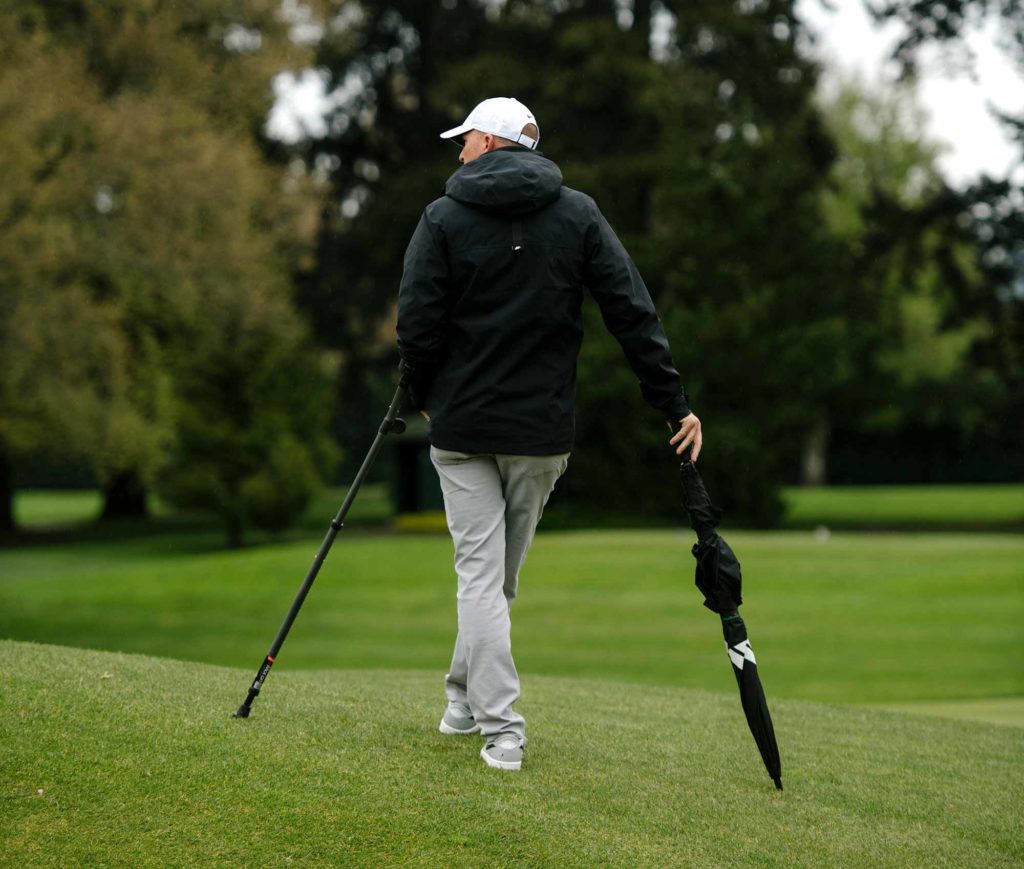
Like all stories, yet more so, Martin’s begins in his mother’s womb. In a random and impossibly rare way, a gene mutated such that the main vein in his right leg that returns blood to the heart never formed. Blood pooled in this leg, further misshaping other veins, and almost from the start Melinda and King Martin knew their baby’s cries were not normal. Finally, at age 4 came a diagnosis: Klippel-Trenaunay Syndrome. Among Martin’s earliest memories is receiving a compression leg sock and being puzzled about the why and how of putting it on. Wrapping his leg tight prevented it from growing engorged and grotesque and would actually make it abnormally thin. This was how the otherwise comfortable son of a wealth manager and homemaker in Eugene, Oregon, grew up, playing sports with his similarly athletic older brother and withstanding the pain that was most acute inside his right knee.
Just whatever you do, don’t break that leg, doctors warned. Golf became a sensible choice – as long as he didn’t step in a hole the wrong way.
“I always knew this would be my destiny, so in many ways I’ve exceeded expectations,” says Martin, who turned 50 on June 2. I’m watching him walk down a hallway at a medical office in Eugene, his pant leg rolled to expose the mechanics of his Ottobock C-Leg prosthesis. A physical therapist scrutinises the slight dip of his spine and gives constant instructions. “You can do all the side planks in the world to try to get ready, but nothing prepares you for this,” Martin says, grimacing. For now, it’s all about training new muscles and shrinking the hot spots, the areas on his stump that hurt most when he takes a step. Martin sings the praises of a marijuana-derived substance that he spreads on a cracker before bed to help him sleep, which he finds funny because as a conservative Christian he has never been high in his life.
When Martin was a freshman at Stanford University in 1991, his best friend was Notah Begay III, a poor kid from the San Felipe reservation in Albuquerque who believed in having a good time and making it to the pros. Martin was always glad to spot Begay a few bucks for food or petrol but threw his hands up when he found his buddy in his dorm room spinning records on a turntable that cost thousands. Together, the two decided to ‘redshirt’ (withdraw from official competition for a year) after their junior year so that they could play a season with an incoming recruit named Tiger Woods. Just like that, there gathered three golfers whose collective future impact on the world – the disabled community, the Native American community and, really, everybody – would exceed their on-course accomplishments. But at that moment in history they were just two dorks laughing at the third rocking war paint, hoop earrings and a popped collar in a college tournament. Or the older two fleecing the phenom for dollars on the practice putting green because they knew the weird breaks. Or the healthy two digging deeper when they heard their always uncomplaining teammate say no more than, “It’s not a good day” as he prepped his leg in the locker room.
Alas, these three amigos came up just short. Stanford had won the national championship in 1994 but finished runner-up in 1995, Tiger’s first season on the team. At dinner with Martin and his old friends at an Italian joint in the shadow of the $270-million track-and-field stadium Phil Knight and Nike just built for the Ducks, the red wine is flowing, and stories about the glory days are coming out.
“Who’d have thought Tiger was going to make us worse,” Martin cackles. “Has to be the only putt of consequence he ever hit poorly in his life,” he says about Tiger’s 25-footer that came up short on the last hole of regulation at Ohio State’s Scarlet course.
“Didn’t have enough speed. Fanned it,” says Will Yanagisawa, the Japanese-American member of this atypically diverse team for that time.
Except for a handful of events his senior year, when X-rays showed the digression of Martin’s tibia to “Swiss cheese”, he walked and carried his bag. When he turned pro after graduation, he walked the humid fairways of the Hooters Tour in summer, the wrapped leg chafing like hell, and wondered if it was worth it. He rode a cart in the first two stages of PGA Tour qualifying school when nobody paid much attention and had one round left before he officially abandoned his pro career and joined his brother and dad in finance. But then he shot 69 to advance to the third and final stage, and soon everybody in golf knew his name.
“I never intended to be an activist,” says Martin, a self-described “carbivore” crushing the bread and olive oil. “I’ve never actually thought of myself as disabled until now. When I’m travelling with the team, and we go to a hotel where there are ramps and elevators, to a golf course where there are hand rails in the bathroom, I’m so grateful.”
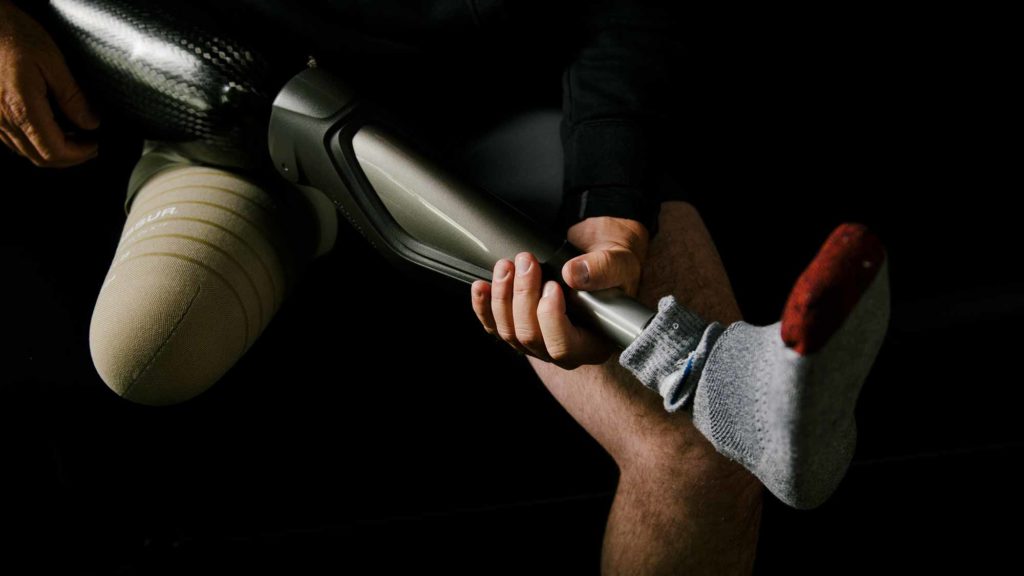
Amid a media frenzy, young Martin’s case evolved beyond whether walking 10 kilometres per round was integral or peripheral to competitive golf and into larger questions about the rights of the disabled to enter mainstream American life. Nobody disputed that Martin’s unfortunate degenerative disease qualified under the Americans with Disabilities Act, but did the ADA apply to professional sports? Alarm was raised that indulging one person could lead to others with less valid conditions to seek special treatment. Jack Nicklaus testified against Martin, though Nicklaus later in life expressed misgivings. The Supreme Court ruled in Martin’s favour, 7-2, but that was in 2001 when the point was moot for Martin, whose short career had essentially played out. Using a cart under a temporary court injunction, he earned his card and played 43 events on the PGA Tour, making 19 cuts. Accounting for hoopla – a US Golf Digest survey at the time found 53 percent of readers were against the ruling – his record gains some lustre.
“When you take on a big institution like the PGA Tour, and it loses, it’s not going to make things easy for you,” says Begay, who captured, remarkably, all four of his career victories in a nine-month span during this time. Modifications to gallery ropes might have made it easier for Martin to find a playing rhythm, but this didn’t happen, and so in addition to the stress of being a rookie was the intermittent anxiety of cutting through crowds in an open-air vehicle. “Each week he was going into this environment where probably the majority didn’t embrace his participation,” Begay says. “It’s an energy, and it was a key challenge to his performance… Growing up Native American, I know what it’s like to walk into a golf club and know people think you don’t belong there.”
In our society’s current era of emphasised inclusion, it’s tempting to wonder how Martin might have fared had he been born 25 years later. “Nowadays, I think public perception and social media would just smash the tour,” says Rich Beem, who famously outlasted Tiger Woods down the stretch at the 2002 PGA Championship at Hazeltine National. “If a guy can play at the highest level with hardly any power in his right leg, I love that, and he should play eight days a week.” Beem was paired with John Daly at the 2019 PGA Championship at Bethpage Black when Daly, citing osteoarthritis in his knee, became the first golfer to take a cart in a Major since Martin in the 2012 US Open at Olympic Club. (Erik Compton, who has had two heart transplants and will need a third, has also used a cart in elite pro competition.) To decide to accommodate a handicap because it is inborn versus acquired is thorny philosophical ground, which Beem acknowledges with a grin. “Daly was smoking cigs and gulping Diet Coke all the way around.”
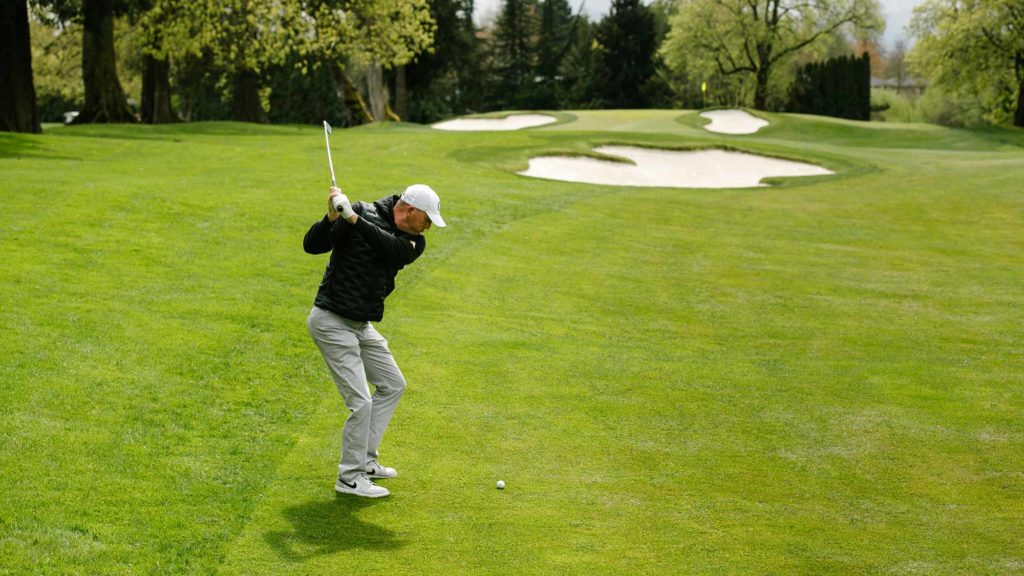
Martin orders a half Pepsi/half Diet Pepsi, a well-earned refreshment after the morning’s physical therapy session, as we settle into cushy chairs inside the clubhouse at Eugene Country Club. “I had no misconceptions that this was going to be easy,” Martin says, swinging his leg underneath the table using both hands. “The goal is to live somewhat of a pain-free existence, to be able to get a cup of coffee or go to the bathroom without it being a hassle, and I’m starting to see the light at the end of the tunnel.”
As to my theory about the timing of his playing career, Martin says, “Absolutely the tour would be better prepared to embrace somebody different in today’s climate. I doubt they would make me go all the way to the Supreme Court.” However, he says that the use of a cart at the tour level remains a legitimate debate. “I have no qualm with someone who disagrees with me,” he says. “It’s a sport, and you have to consider if I receive an unfair advantage.” One can imagine specific scenarios when he might, like a 36-hole day in hot weather on a hilly course, but Martin would rather be the guy with healthy legs. Walking has its own advantage. “To my players, all the time I preach the importance of staying mellow in your mind and body,” he says. “The way I had to fend through crowds with the cart, trying not to hit kids, I was always on edge, my blood pressure spiking.”
When his playing days wound down, Martin was offered the head coaching job at Stanford. There he essentially would have had his choice of the best and most obvious recruits, but the tricky game of sniffing out hidden potential in pimply high schoolers a rung lower and then luring them to the questionable climate of his hometown appealed more. There’s a building in Eugene named after Martin’s great-great-great grandfather, a missionary and fossil hunter who helped settle the town and reconcile tensions between Christianity and evolution. In 2016, the same year the Ducks hosted the NCAAs and hoisted the title trophy, Martin met Catherine Mary Scavo. They married two years later at Eugene Country Club, of course, and moved into a house by the 12th hole.
At age 47, a revelation: Martin had been working on the same three or four things in his golf swing all his life and wasn’t any better. He couldn’t see a difference on video. As a summer experiment, he decided to play with no swing thoughts. “I’m talking nothing. I committed to not pulling the club back until my mind went to zero. On Day 1, I practised for two hours on the range, and it’s a lot harder than you might think.”
First round he tried it he shot 63. On a trip with golf-team boosters to Sand Hills Golf Club, he broke 70 four consecutive times from the tips. Across five weeks, he played 23 rounds and didn’t shoot over par. “It was the best golf I’ve ever played in my life.” Martin had serious talks with his circle about having a go at PGA Tour Champions, which allows carts. His driver clubhead speed was 114 miles per hour, or PGA Tour average, and he started working out with a cross-fit trainer to boost it even higher. By the time he turned 50, distance would be his separator, and he might finally contend and win on TV and cash big cheques like his ball-striking always hinted he could.
Then disaster struck. Because of roadwork outside his house, the curb was eight or 10 inches lower than his motor skills remembered, and while retrieving the rubbish bins at night in the dark, he misstepped – precisely the sort of accident he had avoided all his life. His tibia broken, he writhed in pain on the street until his brother-in-law carried him in.
Martin would spend most of the pandemic in a cast undergoing experimental injections to try to make his diseased bone heal. How much a two-year broken leg exacerbated an already stressed marriage is not for us to know. Martin moved out of his house on crutches, and divorce proceedings piled on the worst period of his life. When he did travel with his team, he limped through airport security with barely a free hand for his mask, always packing light and “living on Aleve”. When it became apparent his leg would never heal, the next move was unfortunately clear.
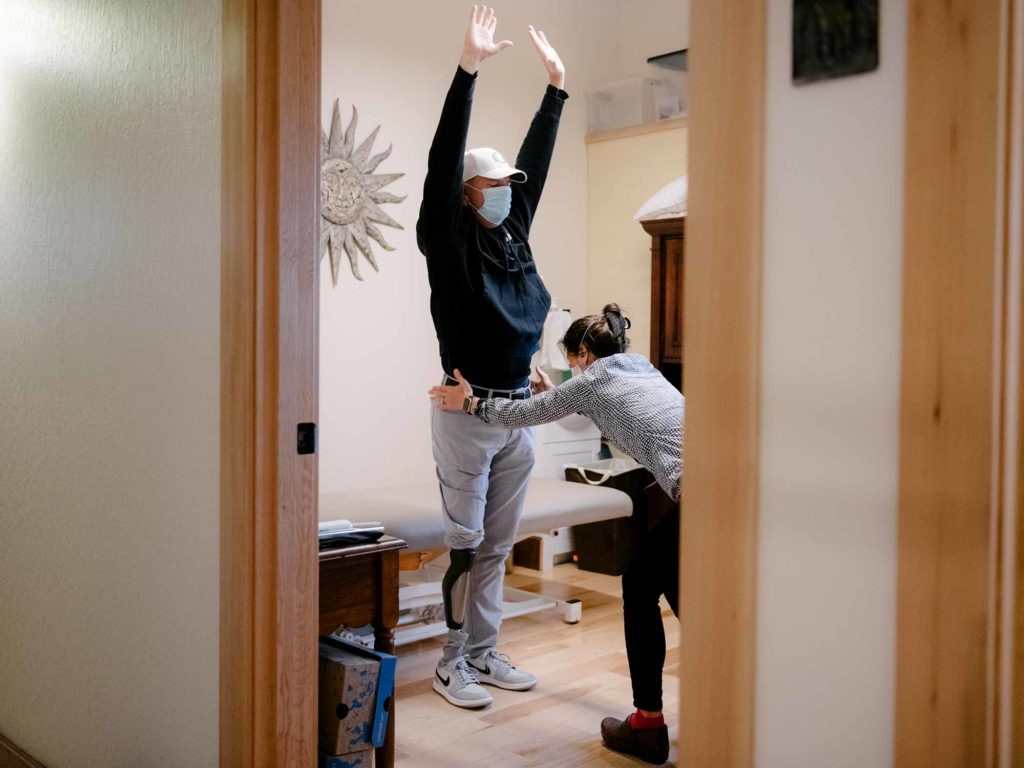
At the Colonial Collegiate Invitational in Fort Worth in early October 2021, 10 days before Martin underwent elective amputation, I watched him hobble 10 yards to a pile of range balls. Leaving his crutches in the cart, he “dragged” (there is no other word to describe it) his broken leg across the turf, its misshapen dead weight obscured by dark pants and a full-length brace. Taking no practice swings, he pured a dozen 8-irons 165 yards with a faint draw to the same flag.
“I’m a stack-and-tilt golfer times a thousand, all my weight on my left side,” Martin said then. “I love to hit golf balls, and so I do, but it’s painful. I can’t hit driver right now, and I can usually last only 30 minutes. But I don’t want this skill to leave.”
Just weeks earlier, in a bad-weather round where Martin somehow encountered only flat lies and crutched onto greens, he had shot 67 and beat everyone on his team. “He still hasn’t let us stop hearing about that,” junior Nate Stember told me at Colonial. This magic round had been shortly after a heavy team meeting in which Martin announced his decision to amputate and how it might affect their season. “He brought it back to golf,” Stember says. “He reminded us that the good times are never as good as you think they will be, and the bad times are never as bad. To hear that from someone who’s accomplished what he has in this game really helps you get through anything.”
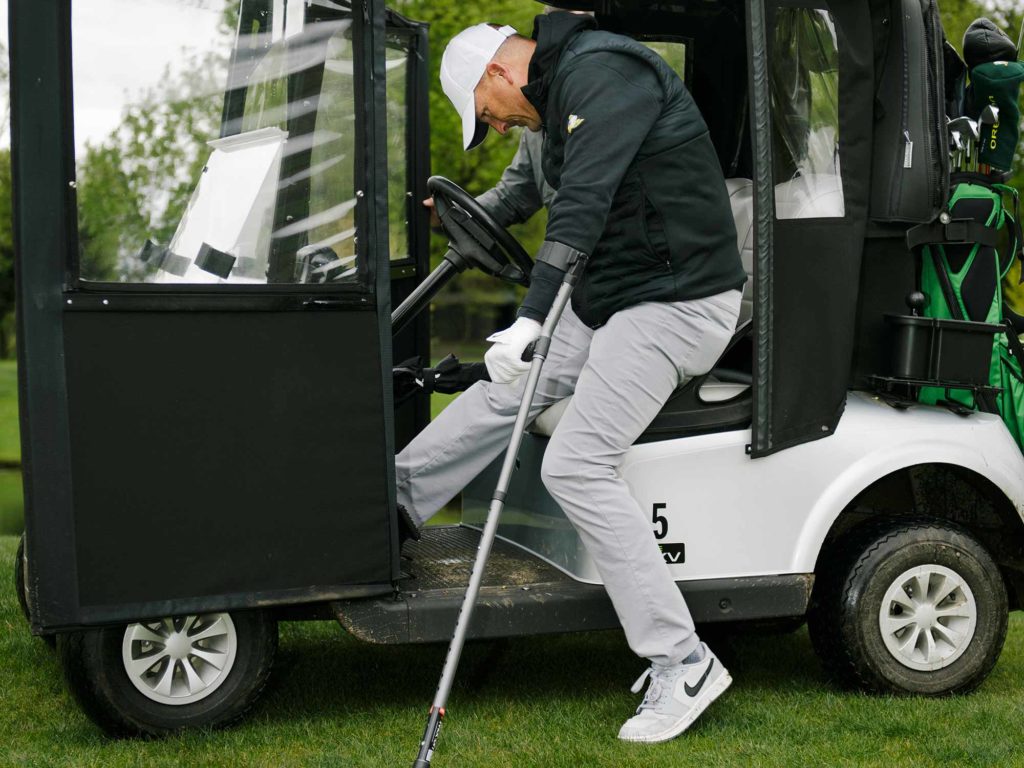
Casey’s Dad stops by our table to say hello. King plays gin rummy at the club nearly every day, competitive games that Casey has been joining lately.
For the amputation, King and Casey’s older brother, Cam, accompanied him to the Mayo Clinic in Rochester, Minnesota. Despite half a year of consultations leading up to it, uncertainty clouded the days preceding the procedure. The doctors could still decide not to go through with it, and if they did, they couldn’t know how high above the knee they would cut until they were inside. With KT, the potential for severe bone bleeding and other life-threatening complications is real, to say nothing of how various surgical outcomes would affect the chances for successful prosthetic fits. Victims of car accidents have more certainty going into amputations.
“Most surgeries you go into hoping you’ll come out better, and this was knowing you’ll come out without a leg,” Martin says. “I’d been imagining it every night for months, so it was a bit like walking to the gallows.” He received countless supporting texts, including one from Tiger calling “Martini” a “tough MF”. No one else has ever called him Martini.
Amputation is truly science and art; the careful dissection of muscle groups and how they’re sutured to the tip of the bone to create padding, the way the nerves and vascular systems are pulled down and then cut and tied, how the flaps of skin are stretched and sewn with the precision of the finest tailor.
One can almost imagine what it’s like to play for coach Martin, to be the recipient of unwavering matter-of-factness. “I woke up and my leg was gone. It was what I expected.”
Actually, the doctors were able to save a larger chunk of his leg than thought likely. But they hadn’t prepared Martin for the possibility of extreme numbness that would feel not unlike full body paralysis. Human nerves are fickle things, and when a patient lies anesthetised in an unnatural position for four hours, weird pinches can happen. “It was very disconcerting,” Martin says. “The doctors took it seriously but said they’d seen it before. But it was two days before I could wiggle my fingers.”
Four days after the surgery, Martin viewed the wound for the first time. Nurses removed a vacuum pump and many layers of bandages to reveal an incision running the length of his inner thigh down to a bloody, swollen stump. “It was gnarly, but it looked healthy.” Martin was encouraged to move about as much as was bearable, so he braved the halls with a walker, feeling blood rush to the area powerfully with each step. Twelve days after being admitted, he flew home. Mercifully, a wealthy friend sent a plane.
Unpleasant sensations that seem to come from a limb that is no longer there are called phantom pains. The spinal cord and brain are accustomed to sending and receiving signals to a body part, and when that part is removed, the nervous system can go haywire. About 80 percent of amputees experience this phenomenon, though the frequency and severity often diminishes within days or weeks. Not so for Martin.
“It’s so intense, so weird,” he says.
“It’s like being plugged into the wall getting electrocuted: big blasts of heat and then extreme pins and needles. They say you feel your old pains, but these were new pains.”
How about now?
“Oh, yeah,” Martin glances under our table. “My right foot is buzzing, but this
is no big deal.”
After the surgery, Martin tried combinations of painkillers unsuccessfully, wary against extreme drowsiness and addiction. Primitive as it might sound, a leading remedy of phantom pain is mirror therapy. Martin did sessions standing with a mirror opposite his remaining leg and looking down so as to trick his mind that he had two legs, that all was in order. Too drugged to enjoy reading, when he wasn’t caring for his stump, he watched TV. “The saving grace was it was football season,” though that November brought other good things.
With assistant coach Jeff Quinney (the 2000 US Amateur champion and a Eugene native) at the helm solo, the Ducks gave Martin a boost by winning the St Mary’s Invitational at Poppy Hills. A week later, the internet erupted when Tiger Woods posted his first selfie video since his car accident, a peppy short-iron swing with the coy caption, “Making progress.” Although a different physical situation, seeing his former teammate and history’s most dominant golfer adapting to a compromised trail leg teased a strange, even cosmic serendipity. Zoom calls with other amputee golfers, arranged by his medical team, further fuelled Martin’s spirits. He learned more about prosthetic limbs that used microprocessors, hydraulics and fine joint articulations that could be controlled through a smartphone app. In the wake of two decades of Middle Eastern warfare, the military had developed many technologies that were just now trickling down to civilians. One of his doctors was an above-the-knee amputee, but Martin hadn’t realised it at first, so smooth was this man’s gait.
Then a setback: infection. Martin was rushed into emergency surgery to remove a bit more leg. Had the surgeons at Mayo perhaps been slightly ambitious in keeping a KT-compromised portion, or had Martin erred in his self-care? Regardless, his timeline for getting a prosthetic leg was now pushed back a month while the new scar healed. This was hard news because for fighting phantom pain, they say wearing an actual leg works a lot better than a mirror.
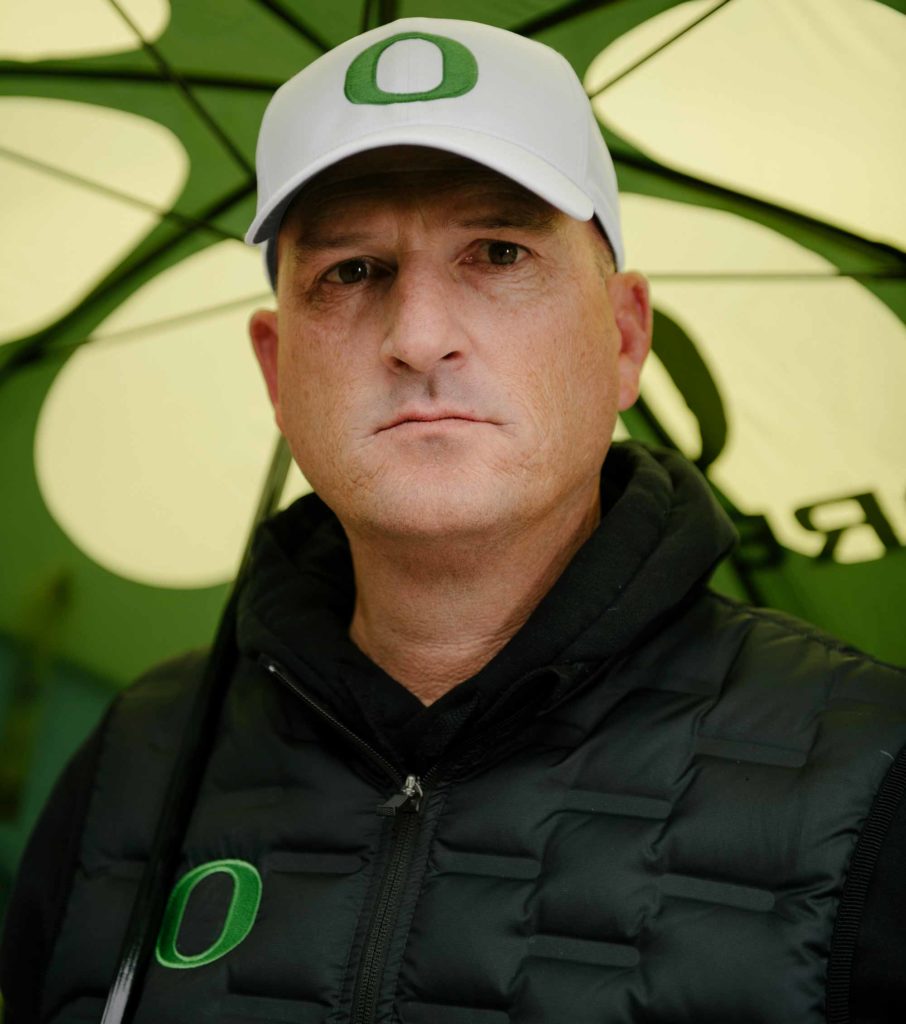
Dr Kevin Carroll is a celebrity in the world of prosthetists for being part of a team that fit a carbon-fibre tail onto a baby dolphin that lost her flukes in a fishing net, which became the inspiration for the Disney hit movie “Dolphin Tale”. An enthusiastic Irishman with a lilting accent, Carroll sounds like he might be a great golfer but isn’t. “I just drive the cart,” he laughs. His colleague, who was also crucial to the dolphin project, Dr Dan Strzempka, plays to an 8-handicap at age 50. Like Martin, Strzempka is also an above-knee amputee of the trail leg.
“We love working with top athletes like Casey because they have high expectations,” Carroll says. In January, Carroll and his team from Hanger Clinics, with Martin’s local doctor, Dr John Roberts, gathered to accomplish in 10 hours what would normally take a patient four to five sessions across several months. Martin wanted to be back in action for the Ducks spring golf season and didn’t care how onerous an expedited process might be.
The materials of a prosthesis are similar to those in golf clubs – lots of lightweight composites, laminates, fabrics and resins that can be shaped and shaved with extraordinary precision, though a custom-fitting is decidedly less fun. On the first try, most patients take two steps and then sit down. Of course, Martin walked the full length of the hallway and back. Eventually he fell, as all do, but he stubbornly walked all day as the team worked on building the ideal leg for him. He did not hide his discomfort nor disappointment but was gracious to those helping him.
Since the initial fitting, the business of returning to work and figuring out how to function as a human hasn’t allowed much time for fine-tuning his golf, which brings us to the practice range at Eugene Country Club, near where we started this story.
“How is it I’m losing 30 yards on a 7-iron?” Martin spits. To our right, seven members of his team are in a row sending missiles in full raingear. “The backswing feels great, but I can’t rotate and clear through. I can’t drive to my left side. Do I stand with both feet together, or do I go one-legged and just bounce around in the finish?”
Martin is taking nice, square divots, but the low trajectory and distance is like he has suddenly aged 20 years. He tees a driver that flies 220 yards and peels right. “This is heartbreaking,” he says.
Yet another notable golf-playing Eugene native is instructor Christopher Smith, who was a pioneer of and multiple record-holder in speed golf, where you run between shots. (However ironically you choose to regard his friendship with Martin, feel free.) Smith has been urging Martin to keep the faith. Particularly, he believes Martin should harness his natural impatience and let it express itself in a faster backswing – really sling it. Indeed, we’ve both seen that Martin is the kind of guy who finishes an entrée in 90 seconds. “We’re going to figure out a way to get a lot of his speed back,” Smith says.
“He’s right on track to where he needs to be,” Dr Carroll says. “I know that’s easy for me to say, but I believe that’s the reality. He’s a superstar, and he might have a really big summer ahead of him.”
Then again, the hitter knows. Despite his intensity, Martin keeps a sense of humour. “I am truly realising the anatomical importance of having a knee,” he laughs. “Even if I can’t figure this out, I still love the game and will enjoy living vicariously through my players.”
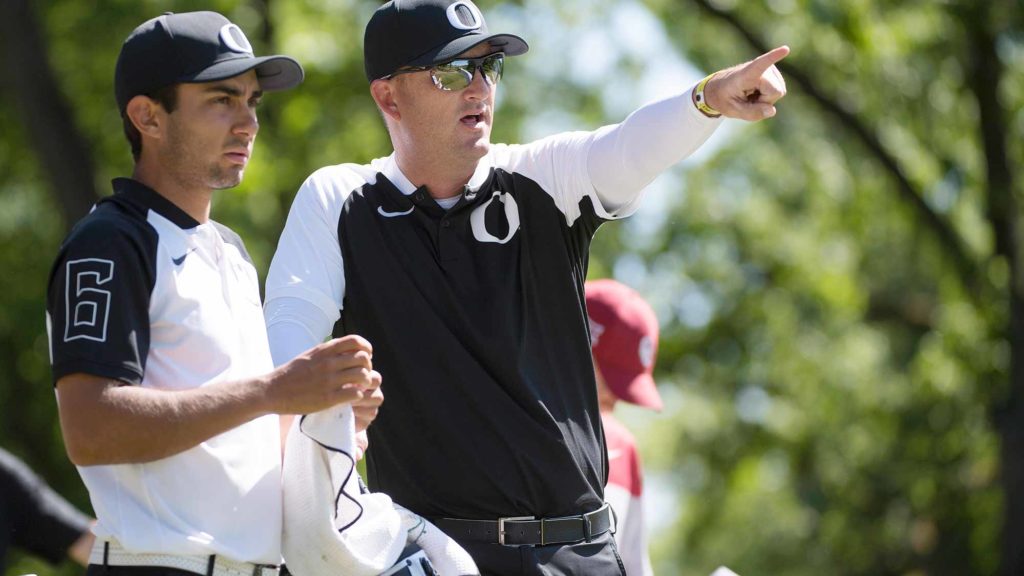
It’s tough to say who is the greatest college coach. John Fields of the University of Texas has had two world No.1s with idiosyncratic swings, Jordan Spieth and Scottie Scheffler, come out of his program. Alan Bratton of Oklahoma State University has cultivated perhaps the most highly regarded program. Mike Small of the University of Illinois seems to have that uncanny ability to insert his wisdom and maturity into underdog golfers. Ryan Hybl of the University of Oklahoma is a name other coaches will bring up. As Fields says about Casey Martin, “If a young player can’t respect that, he can’t respect anything.”
It’s raining pretty hard. But the giant pines soak up most of the water, leaving the turf playable. As we head to the course, Martin doesn’t say a word to his players on the range. No goodbye, no reiteration of tomorrow’s plan. Everything they need to know about golf he has already taught them: how to scout a course, how to form a strategy, how to practise, how to manage emotions, how to be. Golf coaches don’t shout from the sidelines. When any of these kids is standing over a shot in the next big tournament, chances are Martin won’t be there. But the kid will feel him, on that shot and maybe every shot for the rest of his life, like a phantom.
Photographs by Grant Hindsley


